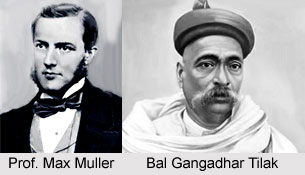 controversy prevails amongst historians about the original home of the Aryans. Historians have advocated four theories in this respect. They have used the art of linguistics, archaeological investigation, racial specialties etc., to prove the site of the Aryans` ancestral dwelling.
controversy prevails amongst historians about the original home of the Aryans. Historians have advocated four theories in this respect. They have used the art of linguistics, archaeological investigation, racial specialties etc., to prove the site of the Aryans` ancestral dwelling.
(1) European Theory
Philologists like P. Filippo Sassetti and Sir William Jone are proponents of this theory. According to them, Sanskrit was only a sister language and not a parent language. They have tried to establish Sanskrit`s resemblance with other European languages. They elucidate that the words `Pitra and Matra` in Sanskrit are the same as `Nater` and `Mater` of Latin, `Pider` and `Mader` of Persian and `Father` and `Mother` in English. This view hints that the Aryans inhabited in some place in Europe and voyaged to various places and the Aryans who came to India, were an offshoot of the Europeans. The new view identifies the following centres as the original abode of the Aryans:-
(a) Hungary-According to Dr. P. Giles and Prof. Macdonell, the ancestral motherland of the Aryans was located in Hungary, i.e., the present-day regions of Austria, Hungary and Bohemia. Cattle rearing and agriculture was possible in this region as a daily occupation. Besides affinity of the languages, flora and fauna with which the Aryans were conversant, could only be from a cold area like this. References of Indian Gods like lndra and Varun have been identified in the excavations of BoghazKoi. Furthermore, the names of monarchs of Babylonia and Mesopotamia are parallel to the names of Indo-Aryans. This depicts that the Aryans arrived in India, through Persia. However, this view has not been recognised by historians.
(b) Germany-According to Brandenstein, the ancestral home of the Aryans was Germany. According to Penka, the celebrated Germany scholar, the Scandinavians have always spoken Indo-European language and people from new nations never came here to settle down. Hence, he considers Scandinavia as the original home of Aryans. Yet again, this theory does not find acceptance by majority of historians.
(c) Southern Russia-Some historians are of the view that Southern Russia was the ancestral home of the Aryans. This theory of Schrader was supported by Dr. B. K. Ghosh, who made a linguistic study to testify it. Specific archaeological evidences also sustain this theory. But Dr. Giles has however wholly declined this theory.
Thus, it is apparent that this theory is based on the affinity of languages. According to this theory, the Aryans had set out from Europe and reached Mesopotamia via South of the Caspian Sea. But both these theories have been subjected to severe criticism by historians and, as a result, this theory holds little significance.
(2) Central Asian Theory
 The chief advocate of this theory is Prof. Max Muller of Germany. Other historians have also supported this theory. The Vedic literature and Iranian book `Zenda-Avesta` illustrates that the dwellers of India and Iran must have cohabited, because many parallels are found. Both were nature worshippers and had agriculture as their chief livelihood. Supporters of this theory indicate Central Asia as the original home of Aryans. Moreover, geographical conditions also substantiate it. According to Prof. Max Muller, Central Asia was the fundamental place from where they voyaged to various places. It has also been established by philologists and geologists that things like pine and birch trees acknowledged by the Aryans, are found here.
The chief advocate of this theory is Prof. Max Muller of Germany. Other historians have also supported this theory. The Vedic literature and Iranian book `Zenda-Avesta` illustrates that the dwellers of India and Iran must have cohabited, because many parallels are found. Both were nature worshippers and had agriculture as their chief livelihood. Supporters of this theory indicate Central Asia as the original home of Aryans. Moreover, geographical conditions also substantiate it. According to Prof. Max Muller, Central Asia was the fundamental place from where they voyaged to various places. It has also been established by philologists and geologists that things like pine and birch trees acknowledged by the Aryans, are found here.
Some historians indicate Pamir or Russian Turkistan as the ancestral home of the Aryans. This is based on the inscription discovered in Boghazkoi in Asia Minor. These inscriptions comprise references to Gods, like lndra and Varun. Certain objects excavated in El-Armana in Egypt suggest that the Indo-Iranian race must have cohabited prior to 1400 B.C. According to Edward Mayor, the Indo-Iranian residents lived in some place near Pamir.
However, oppositions of this theory point out that such a small place can never be the ancestral home of a huge majority of people. Furthermore, this land is not a very productive land. Dr. Giles and other historians have declined this theory. But few scholars have tried to meet criticism against this theory, by remarking that this land was fertile during that time and climate and other conditions might have altered due to natural catastrophes. In respect to the tininess of this region, it is commented that the Aryans had departed from this region due to this sole reason.
(3) Theory of North Pole or Arctic Region
According to late Bal Gangadhar Tilak, the Arctic region was the original home of the Aryans. He commented that the Aryans had not disregarded their motherland and the Rigveda comprises specific references to a place where harsh cold, longer dusks and six months day and night are found. These references propose that the Arctic region must have been the original home of the Aryans. According to Tilak, Aryans departed from this place approximately in 8000 B.C., and from there they colonised in Central Asia in 6000 B.C. In the nonexistence of any written records and based only on the science of Astronomy, this theory has not been recognised by historians.
(4) Indian Theory
Dr. A. C. Dass, late Ganga Nath Jha, Sri L. D. Kalla, Sri. D. S. Trivedi etc., have acknowledged this theory. According to A. C. Dass, Rigveda says that the Aryans were the residents of Sapta-Sindhu. This region stretched from river Indus, reaching up to the Saraswati River. Kashmir and Punjab were also under this region. Dr. Sam-purnanand also backs the theory of Sapta-Sindhu as the ancestral home of the Aryans. Patrons of this theory assert that it has not been proved till now that the Aryans came from outside and suggestions of they being the original inhabitants of someplace near Punjab are very strong. Aryans viewed themselves the residents of Sapta-Sindhu. Had they come from outside, they would have brought Vedas with them. But the fact is just the opposite, because the people who had penned the `mantras` of Rigveda, must have been residents of some place near Punjab. Regarding the affinity of Indian and European language, this theory states that in the language of Aryans, there is a plethora of Sanskrit words, but so is not the case with the latter. If Aryans had come from outside, their ancient literature (Vedas) should also have been found there. But no Vedic literature has been discovered in any place outside India.



















